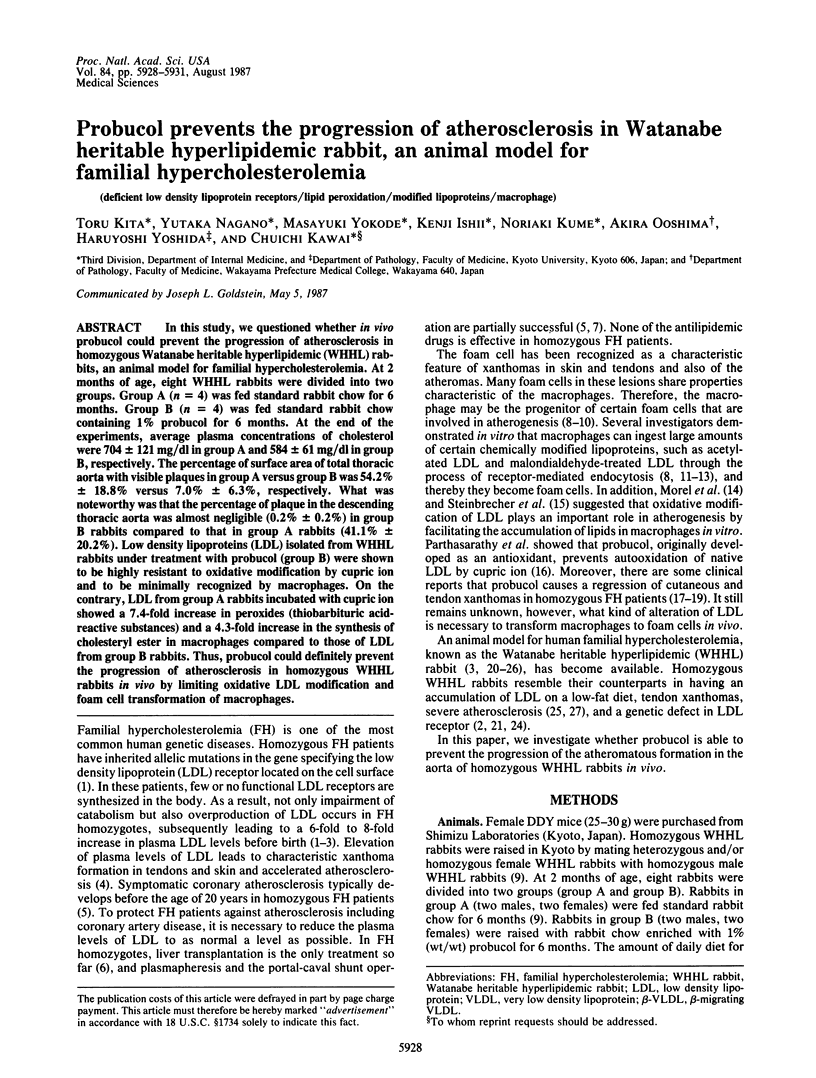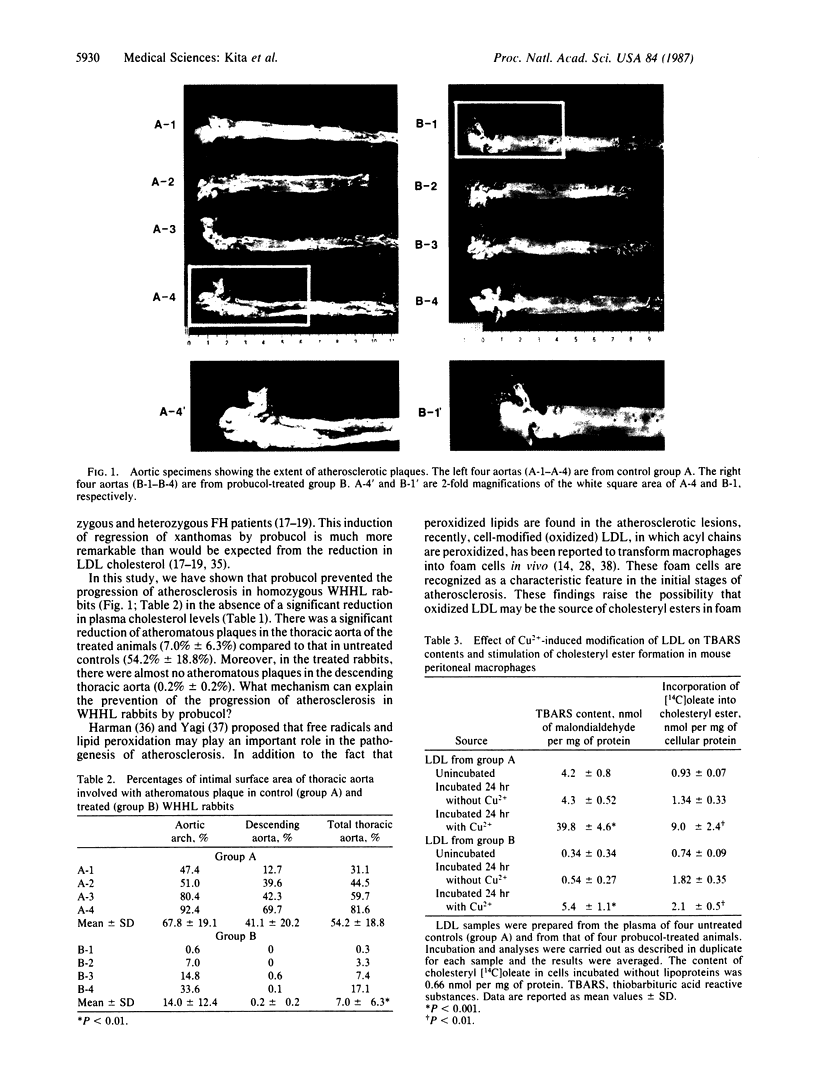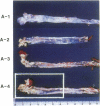Abstract
In this study, we questioned whether in vivo probucol could prevent the progression of atherosclerosis in homozygous Watanabe heritable hyperlipidemic (WHHL) rabbits, an animal model for familial hypercholesterolemia. At 2 months of age, eight WHHL rabbits were divided into two groups. Group A (n = 4) was fed standard rabbit chow for 6 months. Group B (n = 4) was fed standard rabbit chow containing 1% probucol for 6 months. At the end of the experiments, average plasma concentrations of cholesterol were 704 +/- 121 mg/dl in group A and 584 +/- 61 mg/dl in group B, respectively. The percentage of surface area of total thoracic aorta with visible plaques in group A versus group B was 54.2% +/- 18.8% versus 7.0% +/- 6.3%, respectively. What was noteworthy was that the percentage of plaque in the descending thoracic aorta was almost negligible (0.2% +/- 0.2%) in group B rabbits compared to that in group A rabbits (41.1% +/- 20.2%). Low density lipoproteins (LDL) isolated from WHHL rabbits under treatment with probucol (group B) were shown to be highly resistant to oxidative modification by cupric ion and to be minimally recognized by macrophages. On the contrary, LDL from group A rabbits incubated with cupric ion showed a 7.4-fold increase in peroxides (thiobarbituric acid-reactive substances) and a 4.3-fold increase in the synthesis of cholesteryl ester in macrophages compared to those of LDL from group B rabbits. Thus, probucol could definitely prevent the progression of atherosclerosis in homozygous WHHL rabbits in vivo by limiting oxidative LDL modification and foam cell transformation of macrophages.
Full text
PDF



Images in this article
Selected References
These references are in PubMed. This may not be the complete list of references from this article.
- Baker S. G., Joffe B. I., Mendelsohn D., Seftel H. C. Treatment of homozygous familial hypercholesterolaemia with probucol. S Afr Med J. 1982 Jul 3;62(1):7–11. [PubMed] [Google Scholar]
- Bilheimer D. W., Goldstein J. L., Grundy S. M., Starzl T. E., Brown M. S. Liver transplantation to provide low-density-lipoprotein receptors and lower plasma cholesterol in a child with homozygous familial hypercholesterolemia. N Engl J Med. 1984 Dec 27;311(26):1658–1664. doi: 10.1056/NEJM198412273112603. [DOI] [PMC free article] [PubMed] [Google Scholar]
- Bilheimer D. W., Watanabe Y., Kita T. Impaired receptor-mediated catabolism of low density lipoprotein in the WHHL rabbit, an animal model of familial hypercholesterolemia. Proc Natl Acad Sci U S A. 1982 May;79(10):3305–3309. doi: 10.1073/pnas.79.10.3305. [DOI] [PMC free article] [PubMed] [Google Scholar]
- Brown M. S., Goldstein J. L. A receptor-mediated pathway for cholesterol homeostasis. Science. 1986 Apr 4;232(4746):34–47. doi: 10.1126/science.3513311. [DOI] [PubMed] [Google Scholar]
- Brown M. S., Goldstein J. L., Krieger M., Ho Y. K., Anderson R. G. Reversible accumulation of cholesteryl esters in macrophages incubated with acetylated lipoproteins. J Cell Biol. 1979 Sep;82(3):597–613. doi: 10.1083/jcb.82.3.597. [DOI] [PMC free article] [PubMed] [Google Scholar]
- Brown M. S., Goldstein J. L. Lipoprotein metabolism in the macrophage: implications for cholesterol deposition in atherosclerosis. Annu Rev Biochem. 1983;52:223–261. doi: 10.1146/annurev.bi.52.070183.001255. [DOI] [PubMed] [Google Scholar]
- Buja L. M., Kita T., Goldstein J. L., Watanabe Y., Brown M. S. Cellular pathology of progressive atherosclerosis in the WHHL rabbit. An animal model of familial hypercholesterolemia. Arteriosclerosis. 1983 Jan-Feb;3(1):87–101. doi: 10.1161/01.atv.3.1.87. [DOI] [PubMed] [Google Scholar]
- Buja L. M., Kovanen P. T., Bilheimer D. W. Cellular pathology of homozygous familial hypercholesterolemia. Am J Pathol. 1979 Nov;97(2):327–357. [PMC free article] [PubMed] [Google Scholar]
- Fellin R., Gasparotto A., Valerio G., Baiocchi M. R., Padrini R., Lamon S., Vitale E., Baggio G., Crepaldi G. Effect of probucol treatment on lipoprotein cholesterol and drug levels in blood and lipoproteins in familial hypercholesterolemia. Atherosclerosis. 1986 Jan;59(1):47–56. doi: 10.1016/0021-9150(86)90032-8. [DOI] [PubMed] [Google Scholar]
- Fogelman A. M., Shechter I., Seager J., Hokom M., Child J. S., Edwards P. A. Malondialdehyde alteration of low density lipoproteins leads to cholesteryl ester accumulation in human monocyte-macrophages. Proc Natl Acad Sci U S A. 1980 Apr;77(4):2214–2218. doi: 10.1073/pnas.77.4.2214. [DOI] [PMC free article] [PubMed] [Google Scholar]
- Goldstein J. L., Ho Y. K., Basu S. K., Brown M. S. Binding site on macrophages that mediates uptake and degradation of acetylated low density lipoprotein, producing massive cholesterol deposition. Proc Natl Acad Sci U S A. 1979 Jan;76(1):333–337. doi: 10.1073/pnas.76.1.333. [DOI] [PMC free article] [PubMed] [Google Scholar]
- Goldstein J. L., Kita T., Brown M. S. Defective lipoprotein receptors and atherosclerosis. Lessons from an animal counterpart of familial hypercholesterolemia. N Engl J Med. 1983 Aug 4;309(5):288–296. doi: 10.1056/NEJM198308043090507. [DOI] [PubMed] [Google Scholar]
- Harris R. S., Jr, Gilmore H. R., 3rd, Bricker L. A., Kiem I. M., Rubin E. Long-term oral administration of probucol (4,4'-(isopropylidenedithio) bis(2,6-di-t-butylphenol)) (DH-581) in the management of hypercholesterolemia. J Am Geriatr Soc. 1974 Apr;22(4):167–175. doi: 10.1111/j.1532-5415.1974.tb02163.x. [DOI] [PubMed] [Google Scholar]
- Heinecke J. W., Rosen H., Chait A. Iron and copper promote modification of low density lipoprotein by human arterial smooth muscle cells in culture. J Clin Invest. 1984 Nov;74(5):1890–1894. doi: 10.1172/JCI111609. [DOI] [PMC free article] [PubMed] [Google Scholar]
- Kita T., Brown M. S., Bilheimer D. W., Goldstein J. L. Delayed clearance of very low density and intermediate density lipoproteins with enhanced conversion to low density lipoprotein in WHHL rabbits. Proc Natl Acad Sci U S A. 1982 Sep;79(18):5693–5697. doi: 10.1073/pnas.79.18.5693. [DOI] [PMC free article] [PubMed] [Google Scholar]
- Kita T., Brown M. S., Watanabe Y., Goldstein J. L. Deficiency of low density lipoprotein receptors in liver and adrenal gland of the WHHL rabbit, an animal model of familial hypercholesterolemia. Proc Natl Acad Sci U S A. 1981 Apr;78(4):2268–2272. doi: 10.1073/pnas.78.4.2268. [DOI] [PMC free article] [PubMed] [Google Scholar]
- Kita T., Goldstein J. L., Brown M. S., Watanabe Y., Hornick C. A., Havel R. J. Hepatic uptake of chylomicron remnants in WHHL rabbits: a mechanism genetically distinct from the low density lipoprotein receptor. Proc Natl Acad Sci U S A. 1982 Jun;79(11):3623–3627. doi: 10.1073/pnas.79.11.3623. [DOI] [PMC free article] [PubMed] [Google Scholar]
- Kita T., Yokode M., Watanabe Y., Narumiya S., Kawai C. Stimulation of cholesteryl ester synthesis in mouse peritoneal macrophages by cholesterol-rich very low density lipoproteins from the Watanabe heritable hyperlipidemic rabbit, an animal model of familial hypercholesterolemia. J Clin Invest. 1986 May;77(5):1460–1465. doi: 10.1172/JCI112458. [DOI] [PMC free article] [PubMed] [Google Scholar]
- Kritchevsky D., Kim H. K., Tepper S. A. Influence of 4,4'-(isopropylidenedithio)bis(2,6-di-t-butylphenol) (DH-581) on experimental atherosclerosis in rabbits. Proc Soc Exp Biol Med. 1971 Apr;136(4):1216–1221. doi: 10.3181/00379727-136-35461. [DOI] [PubMed] [Google Scholar]
- Kudo S., Akiyama H., Odomi M., Miyamoto G. High-performance liquid chromatographic procedure for the determination of probucol in human plasma. J Chromatogr. 1983 Oct 14;277:419–422. doi: 10.1016/s0378-4347(00)84869-0. [DOI] [PubMed] [Google Scholar]
- LOWRY O. H., ROSEBROUGH N. J., FARR A. L., RANDALL R. J. Protein measurement with the Folin phenol reagent. J Biol Chem. 1951 Nov;193(1):265–275. [PubMed] [Google Scholar]
- Morel D. W., DiCorleto P. E., Chisolm G. M. Endothelial and smooth muscle cells alter low density lipoprotein in vitro by free radical oxidation. Arteriosclerosis. 1984 Jul-Aug;4(4):357–364. doi: 10.1161/01.atv.4.4.357. [DOI] [PubMed] [Google Scholar]
- Parthasarathy S., Fong L. G., Otero D., Steinberg D. Recognition of solubilized apoproteins from delipidated, oxidized low density lipoprotein (LDL) by the acetyl-LDL receptor. Proc Natl Acad Sci U S A. 1987 Jan;84(2):537–540. doi: 10.1073/pnas.84.2.537. [DOI] [PMC free article] [PubMed] [Google Scholar]
- Parthasarathy S., Young S. G., Witztum J. L., Pittman R. C., Steinberg D. Probucol inhibits oxidative modification of low density lipoprotein. J Clin Invest. 1986 Feb;77(2):641–644. doi: 10.1172/JCI112349. [DOI] [PMC free article] [PubMed] [Google Scholar]
- Steinberg D. Lipoproteins and atherosclerosis. A look back and a look ahead. Arteriosclerosis. 1983 Jul-Aug;3(4):283–301. doi: 10.1161/01.atv.3.4.283. [DOI] [PubMed] [Google Scholar]
- Steinberg D. Studies on the mechanism of action of probucol. Am J Cardiol. 1986 Jun 27;57(16):16H–21H. doi: 10.1016/0002-9149(86)90430-3. [DOI] [PubMed] [Google Scholar]
- Steinbrecher U. P., Parthasarathy S., Leake D. S., Witztum J. L., Steinberg D. Modification of low density lipoprotein by endothelial cells involves lipid peroxidation and degradation of low density lipoprotein phospholipids. Proc Natl Acad Sci U S A. 1984 Jun;81(12):3883–3887. doi: 10.1073/pnas.81.12.3883. [DOI] [PMC free article] [PubMed] [Google Scholar]
- Tilton G. D., Buja L. M., Bilheimer D. W., Apprill P., Ashton J., McNatt J., Kita T., Willerson J. T. Failure of a slow channel calcium antagonist, verapamil, to retard atherosclerosis in the Watanabe heritable hyperlipidemic rabbit: an animal model of familial hypercholesterolemia. J Am Coll Cardiol. 1985 Jul;6(1):141–144. doi: 10.1016/s0735-1097(85)80265-5. [DOI] [PubMed] [Google Scholar]
- Watanabe Y., Ito T., Shiomi M. The effect of selective breeding on the development of coronary atherosclerosis in WHHL rabbits. An animal model for familial hypercholesterolemia. Atherosclerosis. 1985 Jul;56(1):71–79. doi: 10.1016/0021-9150(85)90085-1. [DOI] [PubMed] [Google Scholar]
- Watanabe Y. Serial inbreeding of rabbits with hereditary hyperlipidemia (WHHL-rabbit). Atherosclerosis. 1980 Jun;36(2):261–268. doi: 10.1016/0021-9150(80)90234-8. [DOI] [PubMed] [Google Scholar]
- Yamamoto A., Matsuzawa Y., Kishino B., Hayashi R., Hirobe K., Kikkawa T. Effects of probucol on homozygous cases of familial hypercholesterolemia. Atherosclerosis. 1983 Aug;48(2):157–166. doi: 10.1016/0021-9150(83)90102-8. [DOI] [PubMed] [Google Scholar]
- Yamamoto A., Matsuzawa Y., Yokoyama S., Funahashi T., Yamamura T., Kishino B. Effects of probucol on xanthomata regression in familial hypercholesterolemia. Am J Cardiol. 1986 Jun 27;57(16):29H–35H. doi: 10.1016/0002-9149(86)90434-0. [DOI] [PubMed] [Google Scholar]
- Yamamoto A., Takaichi S., Hara H., Nishikawa O., Yokoyama S., Yamamura T., Yamaguchi T. Probucol prevents lipid storage in macrophages. Atherosclerosis. 1986 Dec;62(3):209–217. doi: 10.1016/0021-9150(86)90095-x. [DOI] [PubMed] [Google Scholar]
- Yokoyama S., Hayashi R., Satani M., Yamamoto A. Selective removal of low density lipoprotein by plasmapheresis in familial hypercholesterolemia. Arteriosclerosis. 1985 Nov-Dec;5(6):613–622. doi: 10.1161/01.atv.5.6.613. [DOI] [PubMed] [Google Scholar]






